The 2016 Razer Blade Pro Review
by Brandon Chester on March 6, 2017 8:00 AM EST- Posted in
- Laptops
- Razer
- Razer Blade Pro
sRGB Accuracy
The Razer Blade Pro uses a 17.3" 3840x2160 display. Like almost all of Razer's laptops, this is not an IPS panel. I suspect that it's some sort of vertical alignment tech, but I've been unable to track down the specifics of the panel even though it's known to be a display from Sharp. However, the viewing angles on the Blade Pro are very good, and it doesn't suffer from the yellow tint when viewed off-axis that I noticed on Josh's 14-inch 2014 Blade.
Razer also advertises that the display covers 100% of the Adobe RGB color gamut. I've talked about the issues of using wide-gamut displays on non-color managed platforms so many times in the past that I've grown tired of it, and I'll save it for later when it's most directly relevant. The use of Adobe RGB does necessitate a change from the standard laptop display workflow, so I've split the testing into two sections. This section goes through the standard sRGB analysis to see how things are reproduced in the standard gamut used by almost all computer content, and the next page covers accuracy relative to Adobe RGB and then goes through a greyscale calibration with that gamut as the target.
As always, measurements are done with an X-Rite i1Pro 2 spectrophotometer, except for black level measurements which are done with an X-Rite i1Display Pro colorimeter. Data is profiled and analyzed using SpectraCal's CalMAN software.
Brightness and Contrast
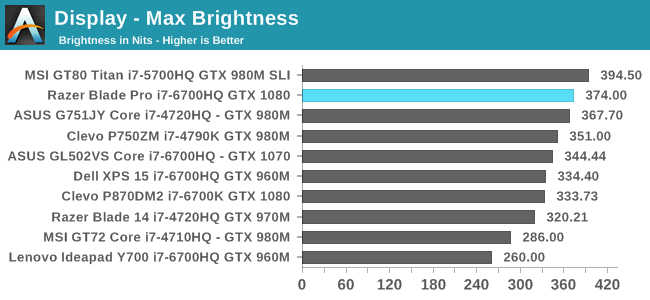
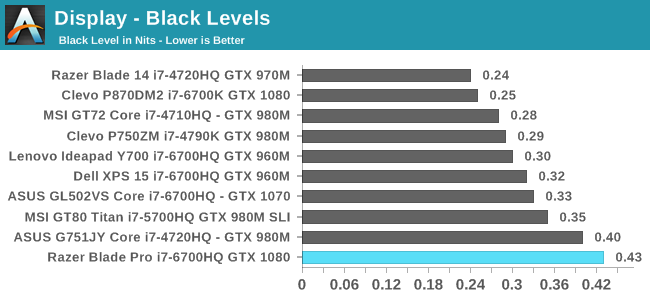
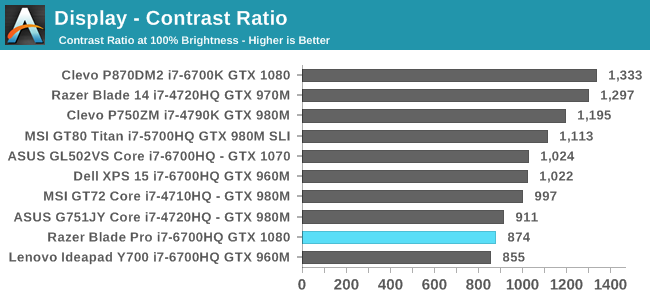
The peak brightness on the Blade Pro is quite good among gaming laptops, but the black level is surprisingly high. The panel razer is using isn't performing as well in this regard as the one used in the smaller 14-inch Razer Blade. I suspect that Razer has little control over this as they need to pick a suitable panel from those that already exist on the market, but it's still disappointing nonetheless.
Greyscale
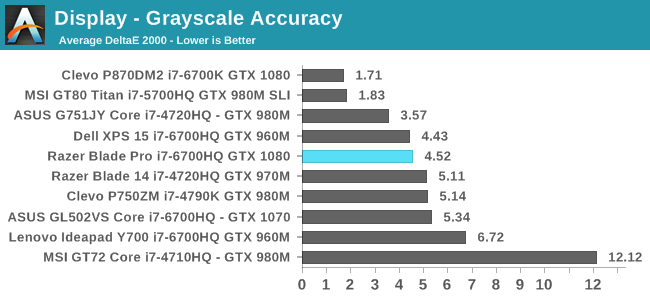
Greyscale accuracy on the Blade Pro is rather poor for such an expensive machine. It's important to note that although this is measuring against sRGB, the white point of D65 and gamma of ~2.2 for our testing doesn't change when testing against Adobe RGB, so this result is applicable to both.
It's clear from the results above that the gamma is too high, with an average value of roughly 2.4 over the entire curve, and a large section where the value is between 2.5 and 2.6. This leads to a generally darker image, as it takes longer for the greyscale to come out of the shadows. However, it would be one thing to have a consistently high gamma, but in this case the issue is both values that are higher than expected and general irregularity in the gamma curve itself.
In addition to the errors caused by the incorrect gamma value at each point, the balance of red, green, and blue components tends towards red for most shades. This causes a noticeable red shift to the display, and the low green component of luminance means that Razer's default calibration actually reduces the display's peak brightness.
The red shifting combined with the irregular gamma leads to a relatively high error level for most shades of grey, with only the very darkest shades providing an acceptable level of accuracy. I honestly don't know what sort of settings Razer was targeting here, because as I mentioned before, these values aren't in line with the spec for sRGB or Adobe RGB, so it's not as though the performance here is going to improve when measuring against Adobe RGB.
Saturation Sweep
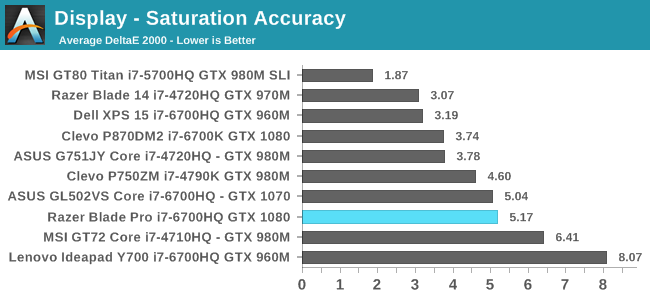
Given that the Blade Pro targets Adobe RGB, it's not surprising to see high error levels for all colors. Even in the case of blue, which has a similar representation for Adobe RGB and sRGB, the red shifting and errors in the gamma throw off the accuracy for all but the deepest levels of saturation. Red is quite inaccurate as well, and green is just hilariously inaccurate, although to be fair, that result is not unintended on Razer's part.
Some readers may be wondering why the errors for red saturation levels are so high even though Adobe RGB and sRGB share the same chromaticity coordinates for red. This highlights one of the limitations of comparing color gamuts using chromaticity diagrams. Although the coordinates for red are the same on the CIE 1976 UCS diagram, the actual CIE XYZ tristimulus values for the colors are not the same. A more simple explanation is that because the green primary in Adobe RGB is significantly more saturated than sRGB, the intensities of red and blue have to be increased in order to maintain the same white representation.
This is fairly intuitive when you think of extending the colors in sRGB. If you represent white in sRGB as (1,1,1), and you increased the saturation of green without corresponding changes to red and blue, your white would start to tend more toward green. Consequently, the appearance of red and blue in Adobe RGB is actually not the same as in sRGB despite the chromaticity coordinates being the same, although in the case of blue the error introduced is on a much smaller scale than for red.
Gretag-Macbeth ColorChecker
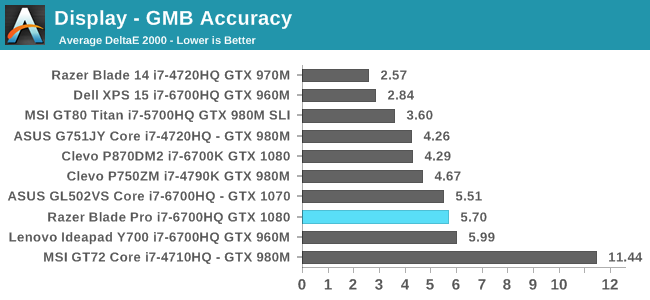
With less than stellar saturation and greyscale accuracy, it's not surprising to see that the Blade Pro struggles to reproduce color mixtures when targeting sRGB.
I really don't have much to say about the Blade Pro's accuracy relative to sRGB, because it was clear to me that it would be poor before I even tested it. If you target one color gamut, you won't be able to correctly reproduce content designed for another color gamut unless you have color management. Windows essentially has no functioning color management, and the few apps that are color managed end up rolling their own solutions or integrating good open source solutions like LittleCMS. Razer should be providing an sRGB color mode much like Microsoft has done on their Surface Studio, which allows proper sRGB color reproduction even with a display that natively has a wider color gamut. If you need sRGB accuracy, the Blade Pro isn't for you.


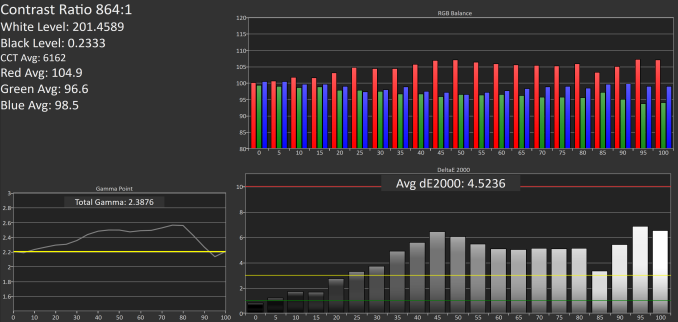
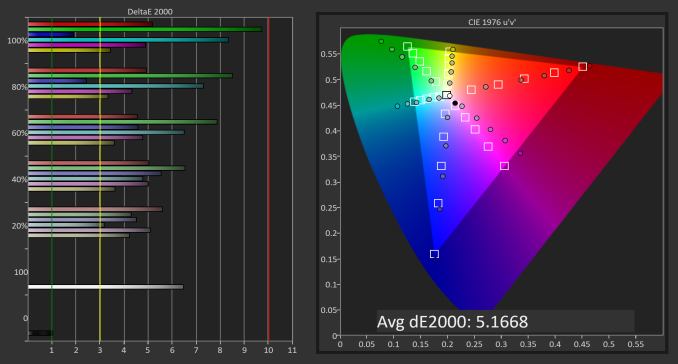








57 Comments
View All Comments
sorten - Monday, March 6, 2017 - link
I prefer plastic laptops to aluminum because I don't want to rest my wrists on a cold laptop in the morning. To each their own.akdj - Tuesday, March 14, 2017 - link
I could be completely wrong but I think I remember seeing a documentary on the building of the triple 7 and 787 (Boeing) and their carbon fiber testing, the results and a line I thought was interesting from one of the folks speaking was his comparison with the aluminum and titanium alloys we'd been using and perfecting... was something to the effect of 'carbon fiber while 'stronger' in some situations and better dealing with fatigue over time... it's not as 'tough' as the metals - in that tests of the fuselage and, I believe, a 'drop test' actually 'broke' the CF fuselage while denting the aluminum fuselage...a test simulated as a hard landingThe findings were escaping from an aluminum fuselage was more survivable than the CF/composite airframe in the case of a post breakup fire (aluminum dented will keep the fire out while the carbon fiber breaking was an immediate entry for fire to the cabin and more fuel)
Not that this has any relevance lol...but the cases you mentioned were also low weight situations (race and space) where 'break ups' are built to absorb energy or for atmospheres with no... atmosphere. Or 'pressures', winds, etc.
Good stuff but metal laptops are just great!
DanNeely - Monday, March 6, 2017 - link
With NVidia calling the current gen of laptop GPUs as being equal to the Desktop versions, I think you should include the desktop cards in the GPU result tables.SkipPerk - Wednesday, April 19, 2017 - link
You still have clock speed differenceszeeBomb - Monday, March 6, 2017 - link
A laptop that I'll (probably) never getzeeBomb - Monday, March 6, 2017 - link
“Using two SSDs in RAID0 is not beneficial, but it does have many drawbacks.” ???Faulty paralleslm here?
Brandon Chester - Monday, March 6, 2017 - link
Good catch. That sentence is a bit awkward. "Not beneficial" was meant to mean, not advantageous. I've reworded it.zeeBomb - Monday, March 6, 2017 - link
OK great. I guess my quick proof reading helped in class hahaZan Lynx - Monday, March 6, 2017 - link
The reviewer keeps harping on the CPU performance, but never acknowledges that a faster CPU would change the power and heat envelope, requiring a bigger power supply, more cooling and a bigger case.Brandon Chester - Monday, March 6, 2017 - link
The TDP of i7-6700HQ and i7-6920HQ are equivalent. I have it on good authority that 6920HQ would have worked perfectly well with no changes to the design of the laptop.